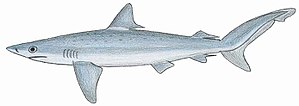Atlantic night shark
| Atlantic night shark | ||||||||||||
|---|---|---|---|---|---|---|---|---|---|---|---|---|

Atlantic night shark ( Carcharhinus signatus ) |
||||||||||||
| Systematics | ||||||||||||
|
||||||||||||
| Scientific name | ||||||||||||
| Carcharhinus signatus | ||||||||||||
| ( Poey , 1868) |
The Atlantic night shark ( Carcharhinus signatus ), often referred to simply as night shark , is a species of the genus Carcharhinus within the Requiem sharks (Carcharhinidae). The distribution area of this species includes several isolated areas in the Atlantic off the coasts of North and South America and West Africa.
Appearance and characteristics
The Atlantic night shark is a medium-sized shark with a maximum length of about 280 centimeters. It has a gray back color without noticeable markings or markings, occasionally black dots can appear. The belly is white and unmarked.
It has an anal fin and two dorsal fins . The first dorsal fin is small and triangular, it begins at the level of the free ends of the pectoral fins. The second dorsal fin is also small, but has a relatively long free end. An interdorsal ridge is present. The snout is long and very pointed, almost V-shaped when viewed from below. In contrast to all other species of the genus, the eyes are strikingly green in color. Like all species of the genus, the animals have five gill slits and no injection hole .
Way of life
The Atlantic night shark lives near the coast above the continental shelf and on the continental slope at depths of 50 to 100, rarely even to over 600 meters. It forms larger groups (schools) and is mainly found and caught at night, which is how it got its name. The shark is very active, and seasonal migrations of the animals are known. It feeds predatory on small bony fish and crustaceans .
Like other species of the genus, it is viviparous and forms a yolk sac placenta ( placental viviparous ). The female gives birth to an average of 4 to 18 young sharks in open water, they are around 60 to 70 centimeters in size.
distribution
The distribution area of this species includes several isolated areas in the Atlantic off the coasts of North and South America and West Africa. It can be found in the western Atlantic from Delaware to Florida as well as around the Bahamas and Cuba . The South American distribution area lies in front of southern Brazil and Argentina . In the eastern Atlantic, the area includes the coastal areas off Senegal , Côte d'Ivoire , Ghana , Zaire and Angola .
Systematics
Together with a few other species, the Atlantic night shark was placed in its own genus night sharks ( Hypoprion ) until a few years ago . These species were the Pondicherry Shark ( C. hemiodon ) and the Hardnose Shark ( C. macloti ); for the smooth-tooth blacktip shark ( C. leiodon ), membership based on the shape of the teeth has been discussed.
literature
- Kuno Sch. Steuben : The sharks of the seven seas: species, way of life and sporting catch. Parey, Berlin 1989; Pages 85 and 99. ISBN 3-490-44314-4
Web links
- Species portrait on hai.ch
- Atlantic Night Shark on Fishbase.org (English)
- Carcharhinus signatus inthe IUCN 2013 Red List of Threatened Species . Posted by: Santana, FM, Lessa, R. & Carlson, J., 2006. Retrieved December 4, 2013.

